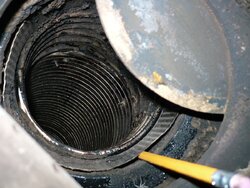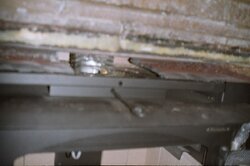I need some advice about how to seal a seam/joint and what high temp product to use.
I have a Freedom Bay with a 6" single wall inside the fireplace chimney. As the pipe comes down and out of the damper, the installer used a 6" elbow to transition between a 3' piece of flex pipe to an elbow and then directly into the top hole of the Freedom bay.
I've clean the pipe and all appears good. After getting the 6" SS pipe clean with my rods and wire brush, inside I take the front metal trim panel off and after 2 seasons of burning, I also check the joint at the top of the insert and it doesn't look good. The space is very narrow (3") between the insert and the damper opening. The White sealant squirted around the seam has turned black. loosened, and cracked away. I shined my flashlight up through the open damper from inside the fire box. Where the joint goes into the top of the insert, most of the joint appears tight, but on place you can see light between the elbow and the insert hole. A lot of light comes through the a gap that is a strip about 1-1/4" along and most of that space is wide enough to put a toothpick between.
The seller of the insert said this morning that the gap in that joint "Isn't a problem. Because it is pulling a draft through the 6" pipe liner, it shouldn't leak unless your pipe is Stopped-Up..."
Then, I asked that since the trim panels are not sealed, couldn't carbon-monoxide leak into the room? The person went to talk to the installer and came back with: "It's not a problem, it won't leak smoke because of the flue draw, and you'll just have to reseal that place every few years."
Would you give me some experienced advice about the installer/company's installation, in view it's out of their warranty, and the accuracy of their information? I spent $17.00 on a tube of 600-degree red silcone sealer to use in the gap, will that work?
Thanks for the help,
Bill
I have a Freedom Bay with a 6" single wall inside the fireplace chimney. As the pipe comes down and out of the damper, the installer used a 6" elbow to transition between a 3' piece of flex pipe to an elbow and then directly into the top hole of the Freedom bay.
I've clean the pipe and all appears good. After getting the 6" SS pipe clean with my rods and wire brush, inside I take the front metal trim panel off and after 2 seasons of burning, I also check the joint at the top of the insert and it doesn't look good. The space is very narrow (3") between the insert and the damper opening. The White sealant squirted around the seam has turned black. loosened, and cracked away. I shined my flashlight up through the open damper from inside the fire box. Where the joint goes into the top of the insert, most of the joint appears tight, but on place you can see light between the elbow and the insert hole. A lot of light comes through the a gap that is a strip about 1-1/4" along and most of that space is wide enough to put a toothpick between.
The seller of the insert said this morning that the gap in that joint "Isn't a problem. Because it is pulling a draft through the 6" pipe liner, it shouldn't leak unless your pipe is Stopped-Up..."
Then, I asked that since the trim panels are not sealed, couldn't carbon-monoxide leak into the room? The person went to talk to the installer and came back with: "It's not a problem, it won't leak smoke because of the flue draw, and you'll just have to reseal that place every few years."
Would you give me some experienced advice about the installer/company's installation, in view it's out of their warranty, and the accuracy of their information? I spent $17.00 on a tube of 600-degree red silcone sealer to use in the gap, will that work?
Thanks for the help,
Bill



